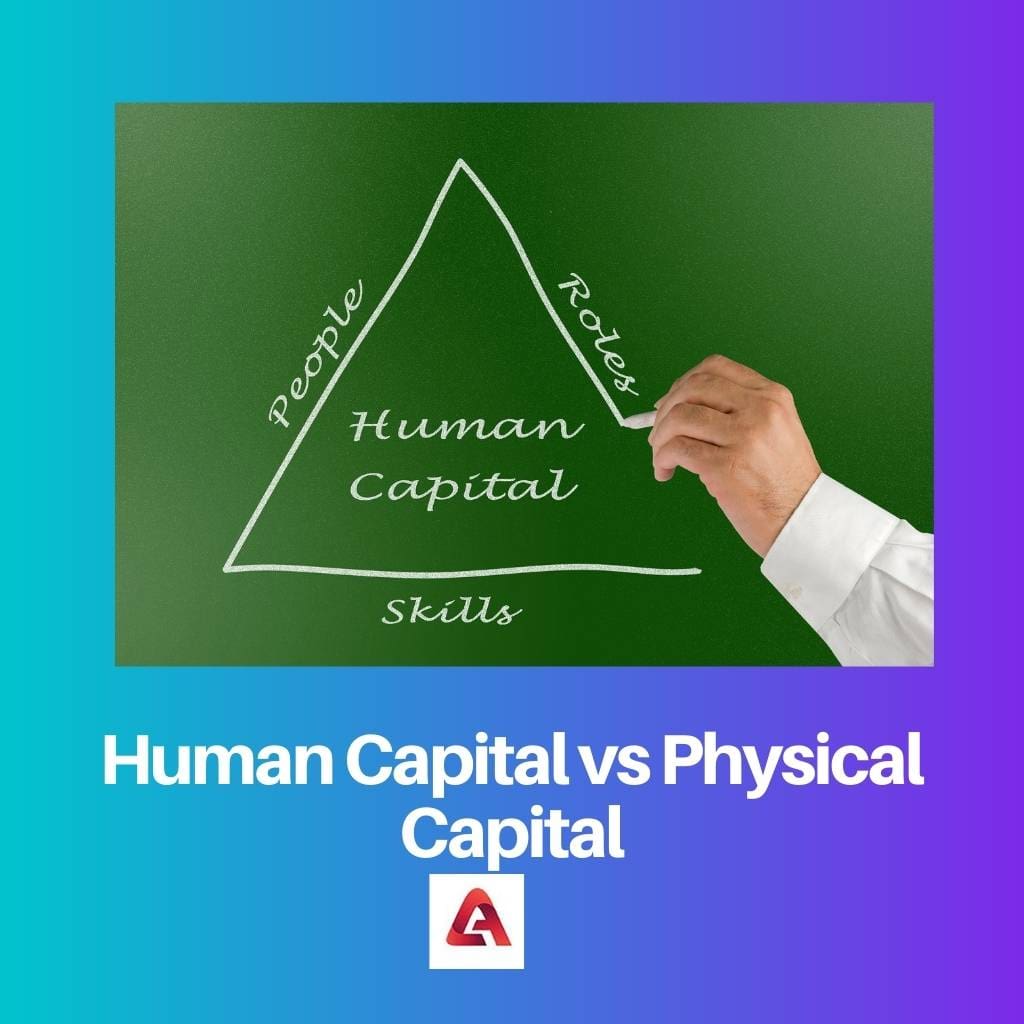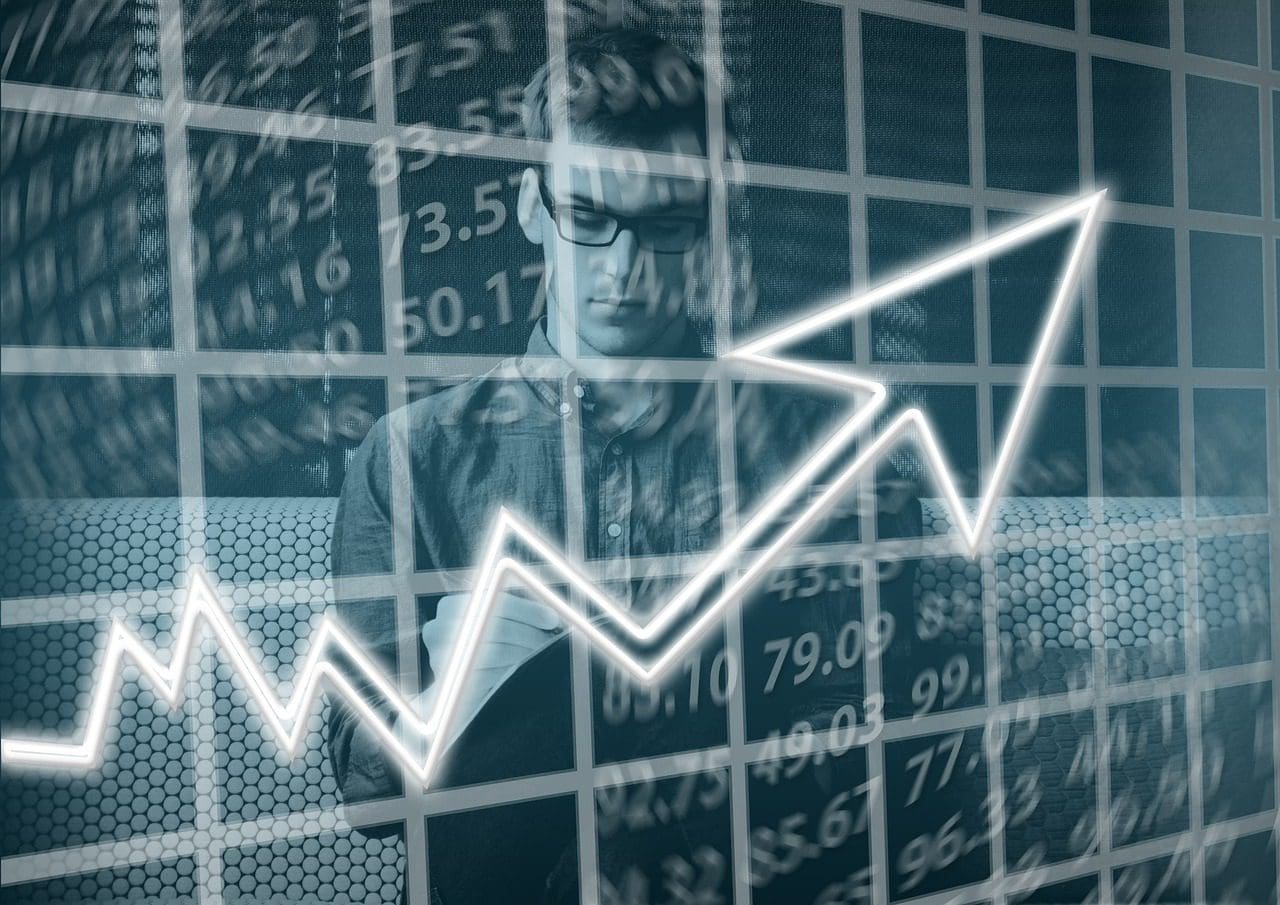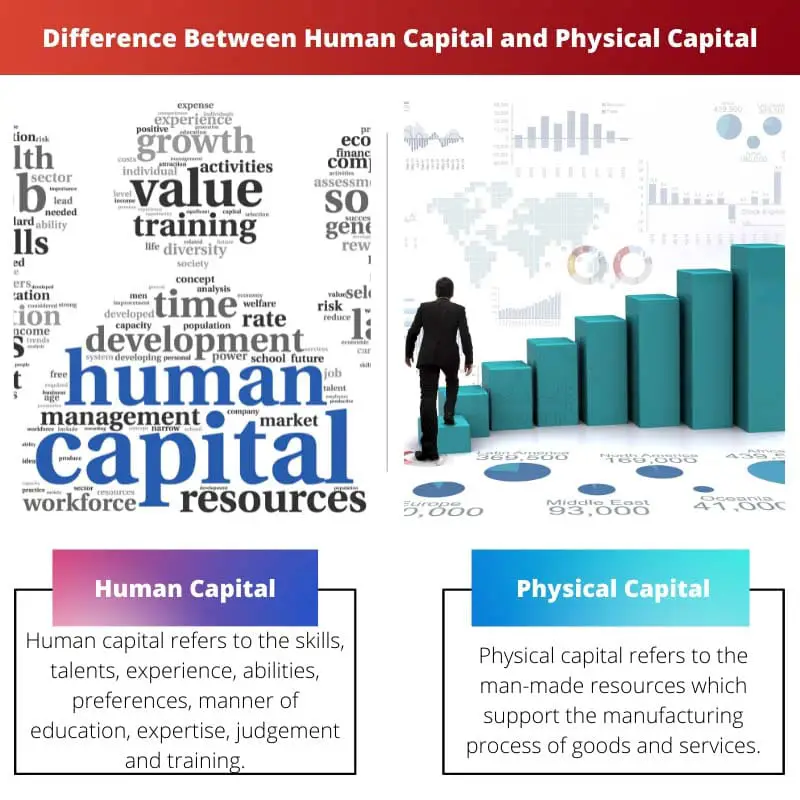In business, capital can be anything that increases the value of your business.
It can add value across a wide range of factors like physical, social, intellectual and financial. In economics and businesses, the two main capitals are human capital and physical capital.
Key Takeaways
- Human capital encompasses the knowledge, skills, and abilities of an individual or workforce.
- Physical capital refers to tangible assets like machinery, buildings, and technology.
- Investments in human capital can increase productivity and innovation, while investments in physical capital can expand production capabilities.
Human Capital vs Physical Capital
Human capital is the skills, knowledge, and experience that people possess and that can be used in the production of goods and services. It includes factors such as education, training, experience, and expertise. Physical capital is the tools, equipment, machinery, and infrastructure used in the production of goods and services. It includes items such as buildings, machines, vehicles, and technology.

Human capital is the collective intangible resources that are possessed by the human. It includes skills, talents, abilities, intelligence, wisdom, judgement, experience and training which can be possessed by an individual or a group.
Using human capital, an economy or a company can generate material wealth.
Physical capital is the man-made tangible resources that support the manufacturing process of goods and services. Physical capital is considered one of the most important capitals of the production process in classical economics.
Physical capital includes machines, equipment, vehicles and buildings. Due to its illiquid nature, the valuation process of physical capital is quite challenging.
Comparison Table
| Parameter of Comparison | Human Capital | Physical Capital |
|---|---|---|
| Meaning | Human capital refers to the skills, talents, experience, abilities, preferences, manner of education, expertise, judgement and training that humans possess individually or collectively. | Physical capital refers to the man-made resources which support the manufacturing process of goods and services. It includes machines, buildings, equipment, vehicles and so on. |
| Nature of resource | Human capital is intangible. | Physical capital is tangible. |
| Formation process | The formation process is not industrial. The formation of human capital is more of a social process in nature. | The formation process of physical capital is industrial. |
| Mobility | Human capital is not portable as there are many restrictions culturally and nationally. | Physical capital is portable between countries except for some government restrictions. |
| Separability | Human capital is not separable from its owner. | Physical capital is separable. It can be separated from its owner easily. |
What is Human Capital?
Human capital is the collective intangible resources possessed by human beings individually or collectively. It includes skills, talents, experience, abilities, preferences, manner of education, expertise, judgement and training, which generates wealth for a company or an economy.
In the late 1950s and the early 1960s, economists from the University of Chicago, Theodore Schultz and Gary Becker, developed a theory of human capital, where they said investing in workers means investing in the capital equipment
as the workers are one of the main factors in the production process.
Gary Becker categorised human capital into two sections- general human capital and specific human capital. General human capital is the qualities and training that have beneficial values to the individual at any organisation.
On the other hand, specific human capital is the education and training which have beneficial values only to the organisation.
Human capital management is spread out all over an organisation. Management actions and decisions that can affect the relationship between the employee and the organisation are considered very important.
So, management actions can affect the human capital potential to impact the performance of the organisation both positively and negatively. Organisations can help to develop human capital, but the ownership of human capital remains in the control of the owner.

What is Physical Capital?
Physical capital is the man-made resources like machinery, buildings, vehicles and equipment which are owned by the organisation. Physical capital is one of the main factors in the production process.
Physical capital demands an extensive amount of investment.
Since the birth of the mechanized production system and capitalism, physical capital has been seen as capital goods. Physical capital is a very important component that adds value to an organisation.
Many types of physical capital are fixed assets that have years of economic life. The physical capitals are not destroyed or consumed during the process of manufacture, but they can be diminished over time.
Physical capital is illiquid, which challenges adding value to the physical capital. Sometimes, equipment and machinery are customized according to the production process and purpose.
So the valuation of the equipment and machinery becomes challenging for the organisation.
For instance, a beverage manufacturing company that has a particular bottle design can suffer from the resale of the bottle-making machine as the machine can manufacture a certain type of bottle. In this case, the valuation process of the machine will be difficult.

Main Difference Between Human Capital and Physical Capital
- Human capital includes inanimate man-made assets like machinery, buildings, vehicles, equipment and so on. On the other hand, human capital consists of skills, experience, talent, manner of education, abilities and so on, which humans possess both individually or collectively.
- Human capital is intangible, and on the other hand, physical capital is tangible.
- Human capital can not be sold at the market, only the service provided by the owner of the human capital can be sold in the market. Like any other commodity, physical capital can be sold in the market.
- Human capital can not be separated from its owner, but physical capital can be easily separated from its owner.
- Human capital is not that easy to transport Internationally as there are migration and cultural barriers. But physical capital can be easily transported internationally.
- Human capital appreciates over time with additional good training and education, and good health. Contrary, physical capital depreciates over time for constant use.

References
- https://dash.harvard.edu/handle/1/34309590
- https://www.tandfonline.com/doi/abs/10.1080/0142569042000236961

The detailed comparison table outlining the parameters of comparison between human and physical capital is an invaluable resource for understanding the unique characteristics of these vital assets in the business context.
Absolutely, the tabulated comparison of human and physical capital facilitates a comprehensive understanding of their distinct attributes, enabling informed decision-making and strategic resource allocation.
I agree, the comparative analysis provides a holistic view of the differences between human and physical capital, which is essential for businesses to leverage these resources effectively for sustainable growth and competitive advantage.
The detailed explanation of the nature, formation process, mobility, and separability of human capital and physical capital is illuminating and enriches the understanding of both concepts.
I particularly appreciate the focus on the formation process and mobility, as these are overlooked aspects when comparing human and physical capital.
This article provides a clear and informative explanation of human capital and physical capital, their differences, and their importance in business and economics.
I agree. The comparison table is particularly helpful for understanding the distinctions between human capital and physical capital.
The comprehensive explanations of human capital, physical capital, and their distinct characteristics contribute to a deeper understanding of their role in business operations and economic development.
Indeed, the article effectively highlights the relevance of human and physical capital in the wider context of organizational management and economic growth.
The definition and comparison of human capital and physical capital provided here are very thorough and insightful.
Absolutely, the distinction between human capital and physical capital is well articulated, making it easy to understand the key differences.
The example provided regarding the categorization of human capital by Gary Becker offers a practical understanding of the concept’s implications.
The enduring significance of physical capital as a key factor in the production process and its implications for value addition in businesses underscore the critical role of strategic investment in tangible assets for sustainable growth and operational efficiency.
Indeed, the insights into the value of physical capital and its contribution to the production process offer valuable guidance for organizations to optimize resource allocation and investment strategies for long-term success and competitive positioning.
The comparison of human and physical capital in terms of their nature, formation process, mobility, and separability provides valuable insights into their distinct characteristics and significance in the business world.
It’s fascinating to see how these two types of capital differ in their nature and mobility, and how those differences can influence business operations and decision-making.
Indeed, understanding the unique features of human and physical capital can help organizations leverage these resources effectively to achieve sustainable growth and competitive advantage.
The distinction and explanation of general human capital versus specific human capital, and how they relate to the organization, offer an insightful view of human capital management.
The details provided regarding the valuation of physical capital and its distinct characteristics are particularly useful for understanding its importance in business economics.
The article effectively discusses the implications of management actions on human capital potential and overall organizational performance.
The role of human capital management in shaping the relationship between employees and organizations is a critical aspect that demands thoughtful consideration and strategic decision-making for sustainable organizational performance.
Absolutely, the effective management of human capital can significantly influence the performance and success of organizations, highlighting the need for proactive measures to develop and leverage human capital for competitive advantage.
The explanations provided here not only define human and physical capital but also offer a comprehensive understanding of their significance in organizational dynamics and economic growth.
Agreed. The article effectively highlights the implications of management actions on human capital potential and overall organizational performance.
The discussions on human and physical capital, including their formation process and significance in business productivity, are truly thought-provoking and offer valuable insights for businesses and economists alike.
Absolutely, the implications of human and physical capital on business productivity and growth are multifaceted and warrant a comprehensive understanding for effective management and investment strategies.
I concur, the analysis of human and physical capital presents a compelling case for businesses to recognize and harness the potential of these resources to achieve sustainable development and competitive advantage.
The information provided here is crucial for understanding the fundamental differences and implications of human and physical capital in business and economics.
Absolutely, the article offers a comprehensive understanding of human and physical capital, and their relevance to organizational management.
The article provides valuable insights into the distinction between general and specific human capital, and how they impact organizational dynamics.
The historical insights into the development of human capital theory, particularly the contributions of Schultz and Becker, offer a profound understanding of the strategic significance of investing in human capital for organizational growth.
Absolutely, the theories of Schultz and Becker have significantly shaped our understanding of human capital and its impact on organizational performance, laying the foundation for strategic HR management and investment practices.
I completely agree. The seminal work of Schultz and Becker has provided valuable insights into the role of human capital in driving organizational success and competitive advantage, emphasizing the importance of strategic investment in talent and expertise.
The emphasis on the significance of physical capital as a major component in the production process and its implications for organizational value creation provides valuable insights for businesses to optimize investment in critical assets for sustainable development.
I concur, the analysis of physical capital underscores the strategic importance of managing tangible assets for business productivity and competitive advantage, emphasizing the need for informed investment strategies and resource optimization.
Absolutely, the discussions on the role of physical capital highlight the importance of strategic asset management and investment practices for businesses to enhance operational efficiency and value creation.
Human and physical capital are key factors for the growth of any business. The manner in which both of them contribute to the productivity and innovation of an organization is fascinating.
I completely agree. It’s important to recognize the value of both types of capital and how they can impact the success of a business.
Absolutely, the distinction between human and physical capital is essential for business owners and managers to understand in order to make informed decisions about investment and resource allocation.
The distinction between human and physical capital, especially in terms of mobility and separability, sheds light on the complexities associated with managing and investing in these resources for organizational success.
Absolutely, managing and investing in both human and physical capital requires careful consideration of their distinct characteristics and implications for business operations and performance.
I believe that understanding the differences between human and physical capital can provide valuable guidance for organizational leaders in optimizing resource allocation and strategic decision-making.
This article effectively outlines the importance of both human and physical capital, and how their distinct characteristics impact business operations and productivity.
The discussion of physical capital as a fundamental component adding value to an organization provides a valuable perspective on its role in business operations.
The complexities associated with the valuation and customization of physical capital offer thought-provoking insights into the challenges and considerations involved in leveraging tangible assets for value creation and sustainable growth in businesses.
I agree, the discussions on the illiquidity and customization of physical capital underscore the need for businesses to adopt prudent investment and asset management practices to overcome valuation challenges and maximize operational efficiency.
Absolutely, the complexities surrounding the valuation and customization of physical capital present critical challenges for businesses, necessitating strategic approaches to optimize asset utilization and long-term value creation.